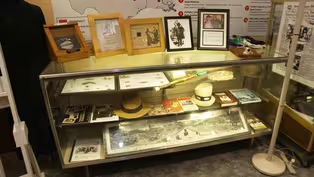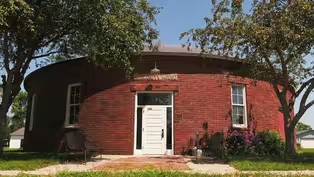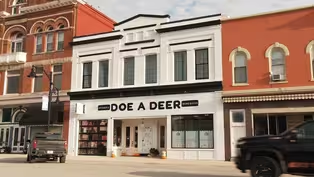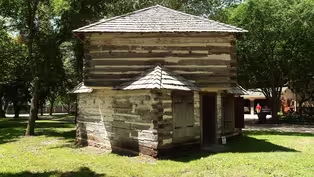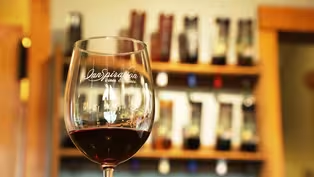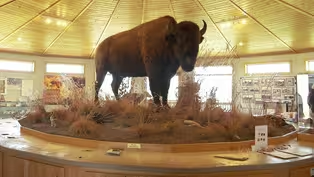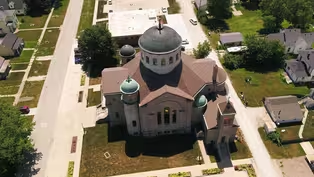
History of the White Pole Road
Clip: Season 1 Episode 109 | 4m 9sVideo has Closed Captions
Discover the historic figures who came through Iowa on one of the state's first blacktops.
Discover the historic figures who came through Iowa on one of the state's first blacktops.
Problems playing video? | Closed Captioning Feedback
Problems playing video? | Closed Captioning Feedback
Road Trip Iowa is a local public television program presented by Iowa PBS

History of the White Pole Road
Clip: Season 1 Episode 109 | 4m 9sVideo has Closed Captions
Discover the historic figures who came through Iowa on one of the state's first blacktops.
Problems playing video? | Closed Captioning Feedback
How to Watch Road Trip Iowa
Road Trip Iowa is available to stream on pbs.org and the free PBS App, available on iPhone, Apple TV, Android TV, Android smartphones, Amazon Fire TV, Amazon Fire Tablet, Roku, Samsung Smart TV, and Vizio.
Providing Support for PBS.org
Learn Moreabout PBS online sponsorship♪♪ Connecting the towns of Dexter, Stuart, Menlo, Casey, and Adair, the White Pole Road Scenic Byway traces an historic thoroughfare in west central Iowa that dates back to the early 20th century.
Gilman: Iowa got the reputation of being a gumbo state because when it would rain or snow, the roads that they had, the dirt roads would just turn to mush.
So, the governor at the time was B.F. Carroll, and he called for a Good Roads Convention in 1910.
So they had all these people, these road enthusiasts and people from communities in all of the counties in Iowa, and they all converged into Des Moines and they had a convention to talk about how they could improve the roads.
So, from that, they came up with the River-to-River Road.
Kohlsdorf: Beyond Des Moines, the River-to-River Road ventured north, but the White Pole Road Auto Club, headquartered in Menlo, argued that their route, part of the cross-state Great White Way, was the shorter and faster path westward.
Gilman: We were very tenacious, the leaders in our community, because they knew the value of a good road going through their town.
They knew that people would travel through there, they'd have money to spend at restaurants and bars and shops and things, and so there was going to be more commerce coming through their town.
Kohlsdorf: The White Pole Road derives its name from the distinctive white-painted telephone poles that lined its route, providing a visual marker for travelers.
In 1931, sections of the White Pole Road became part of transcontinental U.S. Highway 6.
The road served as a vital artery for commerce and travel in that region, bringing all kinds of people through central Iowa.
Gilman: I think people travel because they want to seek opportunities and they want that adventure.
You're always wondering, you know, what's behind that next bend.
And so that gets people to want to migrate.
And so they migrated west.
I mean, the whole western expansion happened right along our corridor.
It started with, like, the stagecoaches, and then you had the railroads and then the Underground Railroad.
Kohlsdorf: Pull over in Adair at the site where Jesse James conducted what is said to have been the first robbery of a moving train.
Motor into Stuart knowing you're firmly in the tracks of outlaws Bonnie and Clyde and beatnik rider Jack Kerouac, whose journey across Highway 6 was immortalized in his classic American novel "On the Road."
Pass by the renovated Stuart Depot, which enabled westward expansion long before roadsters and highways.
Arrive in Dexter, where Bonnie and Clyde nearly met their match at the hands of a local posse.
♪♪ With the advent of the Interstate Highway System in the 1960s, the communities along the White Pole Road experienced less traffic and decreasing economic activity.
In 2002, the White Pole Road Development Corporation was formed to preserve the legacy of this short stretch of blacktop.
In 2016, the White Pole Road became an official State of Iowa Scenic Byway.
Today, the byway stands as a testament to Iowa's rich transportation history, reminding visitors of a bygone era when roads were lifelines that connected communities and shaped the landscape of the American Midwest.
So if you choose to get off, say, in Adair and you're traveling along, you're like, "Oh, my gosh, this is going too slow.
I got to get back on the interstate," the next town is coming right up, and you can hop back on because it never gets further than two miles from Interstate 80.
Lots of times, my husband and I just like to get off an exit and we just like to seek out those little two-lane roads and just slow down and enjoy Americana up close.
You're always going to remember your trip if you go on a byway.
♪♪
Video has Closed Captions
Clip: S1 Ep109 | 2m 57s | From outlaws to presidents, find out who passed through Dexter on White Pole Road. (2m 57s)
Video has Closed Captions
Clip: S1 Ep109 | 1m 3s | Dexter's one-of-a-kind community center and gym is a century-old architectural wonder. (1m 3s)
Video has Closed Captions
Clip: S1 Ep109 | 4m 37s | Doe A Deer's unique graphic textiles bring a fresh vibe to Stuart's historic main street. (4m 37s)
Video has Closed Captions
Clip: S1 Ep109 | 1m 16s | Explore Peterson's frontier history at the county's first frame house and fort. (1m 16s)
Video has Closed Captions
Clip: S1 Ep109 | 2m 24s | Paul and Sheila Thomsen's vineyard began as decor and turned into a full-fledged winery. (2m 24s)
Video has Closed Captions
Clip: S1 Ep109 | 2m 31s | Discover how glacial activity shaped Iowa's landscape at the Prairie Heritage Center. (2m 31s)
Video has Closed Captions
Clip: S1 Ep109 | 3m 50s | Following a tragic act of arson, Stuart's All Saints Church was resurrected from ashes. (3m 50s)
Providing Support for PBS.org
Learn Moreabout PBS online sponsorshipSupport for PBS provided by:
Road Trip Iowa is a local public television program presented by Iowa PBS
